| Churches and Religion
The Old Meeting House
The Convention Parliament, set
up in 1660 to reorganise the country after the civil
war, had the responsibility of effecting a
reconciliation in the Church of England. This led to
the Savoy Conference of 1661, in which 12 Anglican
bishops and 12 ministers from the Puritan and
Presbyterian churches, along their assistants,
attempted to revise the Book of Common Prayer.
The Act of Uniformity followed
in 1662. Around 2,000 Anglican ministers refused to
comply with the terms of the Act and so were evicted
from their livings. One of them, Joseph Eccleshall,
had been vicar of Sedgley since 1657. Before the end
of 1662 he moved to Coseley and started to hold
services in a private house near Wallbrook. The
congregation was known as ‘The Old Meeting
Congregation’. He built-up a sizeable following, so
much so that on his death in 1692, the funeral
service was attended by so many people that the
floor gave way and collapsed into the cellar,
resulting in a number of injuries.
In 1717 the original
Presbyterian chapel was built in Old Meeting Road,
at Old End, which became known as ‘The Old Meeting
House’. This was the first church of any
denomination to be established in Coseley. In 1735 a
school room was built behind the church. It is thought
to be the earliest school in Coseley. Samuel
Bourn and other church officials made it their
responsibility to provide education for the children
of Coseley, who would otherwise have had no
education at all.
In the early 1830s, the
minister was John Cooper, an enthusiastic supporter
of the Reform Bill of 1832. He antagonised many
members of the congregation by his outspoken views
and was asked by the trustees of the church to
resign. He took legal action against them, but was
unsuccessful in his bid to remain at the church. He
attempted to establish another church in the
locality, but could not gain the necessary support.
He soon left Coseley and became a minister at a
church in Lutton and another at Fleet, both in
Lincolnshire.
The original chapel was destroyed by fire on the
15th July, 1872 and replaced by the existing
building,
which opened on 10th August, 1875. The chapel
has its own burial ground
which dates back to the 1700s.
As a result of the Toleration Act of 1813, the
chapel became Unitarian under the Reverend H. Euchus,
J.P. who came to Coseley in 1865. Thanks to
his efforts, the chapel was able to sell or lease
the mines at the Coppice, that belonged to the
church. The money received was used to fund the
rebuilding of the chapel in 1874/75. |
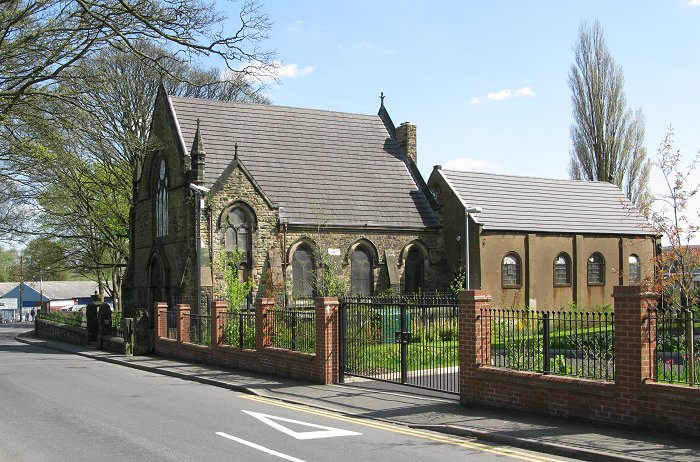
The Old Meeting House.
|
Providence Baptist Church
Providence Church in Hospital Lane,
was formed about 1805, as a result of the split in the Darkhouse congregation. In the early years, converts to
the faith were baptised in the canal at Coseley and at
Bloomfield. The chapel was built in 1809 and had two
galleries, one of which was occupied by the choir and an
orchestra, until an organ was installed in 1845.
The congregation grew to such an
extent that the original chapel became too small and so
was replaced by a larger building in 1870. The chapel
became connected with the Turley family, who worshipped
there for several generations. Two members of the
family, James and Sarah Turley are buried in a vault
beneath the church.
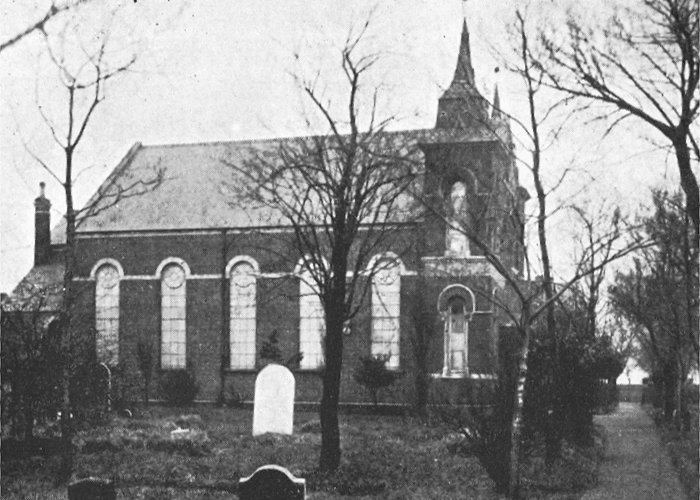
Providence Baptist Church. From an old postcard.
The Ebenezer Chapel
The Ebenezer Chapel in Ebenezer
Street, began in about 1856 when some of the congregation
from the Providence Baptist Chapel became dissatisfied
with the church. They decided to hold their own services
in Isaac Richards’ house, in Coseley Bull Ring. They also
held open air services at a place called the stone
stile. They then moved to Coseley Hall barn in Old
Meeting Road that was owned by Mr. Barnett, who also
owned Coseley Hall.
Members of the congregation
assisted in digging the foundations for the Ebenezer
Chapel in 1857. The chapel opened on the 7th September,
1858 under the leadership of the Reverend W. Jones, who
remained there until 1861. The first major renovation
took place in 1889, and another in 1939.
The chapel is now called The New
Hope Baptist Church.
Methodist Churches
Methodist Churches were built at
Lanesfield, Ladymoor, Bradley, Daisy Bank and in the
centre of Coseley itself. Members of the Methodist New
Connexion built chapels in Wallbrook and Swan Village,
and the Primitive Methodists built churches at Cinder
Hill and Ettingshall.
Hall Green Methodist Church appears
to have been formed as a result of John Wesley’s visit
to Hurst Hill, sometime after 1761. Two of his converts,
‘Honest Munchin’ and Francis Ward, formed a small local
society and held meetings in a room above two wash
houses. The room soon became too small for the growing
congregation and so John Wilkinson, the iron master,
built a Cast Metal Meeting House for them in about
1790. This burned down in the early 19th century and
replaced by a new chapel in 1835, that was rebuilt in
1902. It is now called Bradley Methodist Church.
A small group of Wesleyan
Methodists held services in Thumper's Lane, which was
near the windmill on the western side of Coseley. A
chapel was built for the worshippers, mainly thanks to
the efforts of the Flavell family. Unfortunately it had
a short life because of the effects of subsidence from
local coal mines and closed at the beginning of the 19th
century.
A group of Methodists began meeting
in a small chapel in Mamble Square, Coseley, which became
unsafe due to coal mining. A new chapel was built in the
square that could accommodate around 500 people. The
first service was held on July 17th, 1853. A school was
also built on the site.
Another church became established
at Upper Ettingshall, which was visited by a group of
Primitive Methodist missioners from Darlaston in the
early 1820s. They made a considerable impression upon
some of the inhabitants including Thomas Nichols, a
miner living in the Big Fold. He opened his house for
worship and became a Primitive Methodist with a
flourishing congregation. He was born in 1790 and lived
in one of two small houses joining the Chapel in Chapel
Street, later called Paul Street.
Upper Ettingshall Methodist Church
was built on a plot of land covering 174 square yards,
on the corner of Paul Street and Upper Ettingshall Road,
that was purchased for £19.10s.0d. in 1829.
A single storey church
was built in 1834. More land was soon acquired and the
original church was demolished to make way for a larger
church, built in 1850. In 1853, after Thomas Nichols’
death, the two houses joining the church
were demolished to make way for a Sunday School.
The church was renovated in the
early 1920s after suffering from subsidence caused by
coal mining. It closed during the renovation and
re-opened in December 1922. In 1924 a
pipe organ, built by
Mr. Norton of Ocker Hill was installed. In 1986 it was
renovated and enlarged. Further
additions and alterations included the building of a
kitchen in the 1940s; alterations to the choir stalls
and the replacement of some of the pews with modern
seats, and the installation of a new pulpit in 1957; and
the demolition of the caretaker’s house in 1959. The
Sunday School has since been extended and new seating
and carpets have been fitted in the church.
Hurst Hill Methodist Church was
built in 1864 in Gorge Road, Hurst Hill. It survives
almost in its original condition, with its gallery,
original box pews and plaster ceiling. It is built in
vernacular brick classical style with the original
schoolroom next door. It was locally listed by
Wolverhampton Council in November 2001.
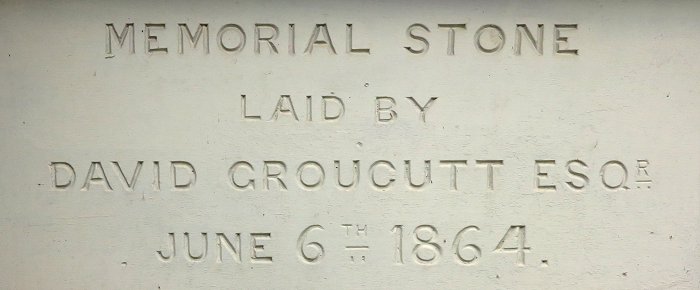
Hurst Hill Methodist Church
foundation stone.

Hurst Hill Methodist Church.
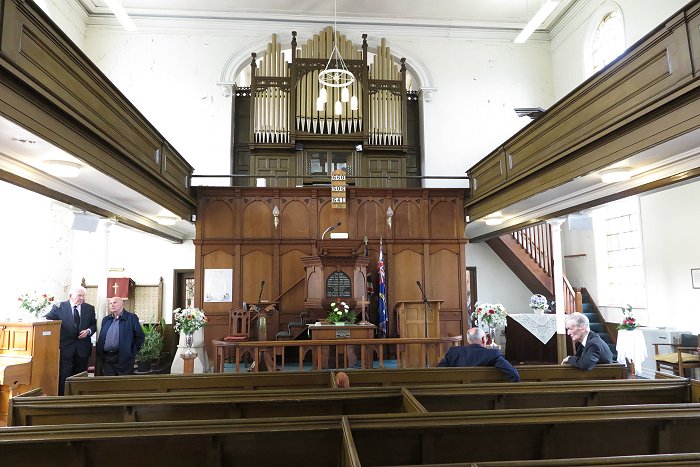
The church interior.
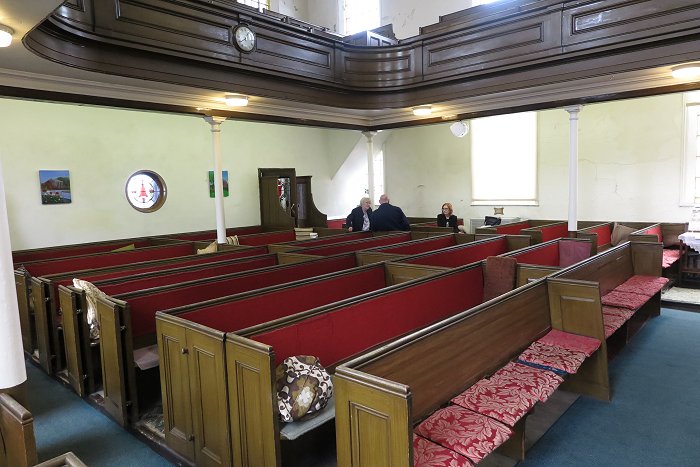
The box pews and the gallery.
|
|
Anglican Churches
The main Anglican Churches in
Coseley all date from the 19th century, because prior to
that, local Anglicans worshipped at Sedgley Parish
Church, which by the beginning of the 19th century had
fallen into a bad state of repair. In 1825, Lord Dudley,
who was lord of the manor, gave £2,000 towards the
expense of demolishing and rebuilding the church. He
also gave a piece of land at Coseley that was to be used
for the building of a parish church. In 1826, Lord
Dudley offered to rebuild Sedgley church at his own
expense, providing the parishioners would “transfer their
subscriptions” to the building of the church at Coseley.
|

Christ Church. From an old postcard.
|
The cost of building Christ Church,
in Church Road, Coseley, was met by the Church
Commissioners and public subscriptions. Building work
began in 1827, the first stone being laid by Henry
Ryder, Bishop
of Lichfield and Coventry, on the 9th August, 1827. Just
over three years later the church was consecrated. The
ceremony was held on the 27th August, 1830.
The following contemporary
newspaper account explains the importance of the church
to the locals:
|
This Chapel, which is a neat and
elegant structure of the plain Gothic order, has been
erected partly by subscriptions and partly by His
Majesty's Commissioners, and is calculated to contain
2,000 people; it is situated in the centre of a dense
population, which, from their distance from the Mother
Church (Sedgley) have been in a great measure prevented
from attending the worship of Almighty God, according to
the ritual of the Church of England.
Mr. Rudge opened the organ, a fine
old instrument, removed from Wednesbury Church, and
greatly improved by Mr. Bishop - the cost of which is to
be defrayed by the collections, these amounting in all
to £100.
|
|
The organ came from St. James’
Church at Wednesbury.
Coseley church was originally a
chapel of ease to Sedgley Parish Church, the first
curate being the Reverend F. Foreman Clark. In 1832,
Coseley became a separate district parish, but was still
under the control of the vicar of Sedgley. At this time,
the church school was built next to the church, in
Church Road, at a cost of £600, mainly paid for by a
private individual. Pupils were admitted to the school
only on the recommendation of subscribers to the church.
The first master was the church’s choir master, Mr.
Fieldhouse.
|
|
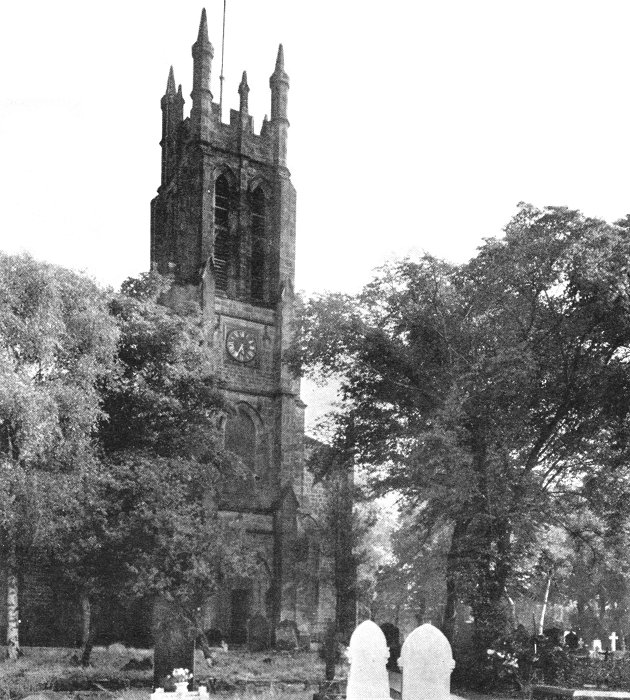
Christ Church. |
|
In 1847, the church’s single bell
was replaced by a peal of 8 bells that were hung in the
tower. Around the same time, the first stained glass
window was installed in the church. In 1866, the chancel
was extended by 15 feet, and the organ, which had stood
in the west bay, was moved to an open bay on the north
side. Choir stalls were also added and the ceiling was
panelled.
In 1888, a new wooden floor was
fitted and the pew rents were discontinued, so from
then-on, it was free to worship in the church. Other
subsequent improvements include the erection of the oak
chancel screen and the fitting of a new east window in
the chancel. Two years later a new organ was installed,
which used many parts from the original organ.
|
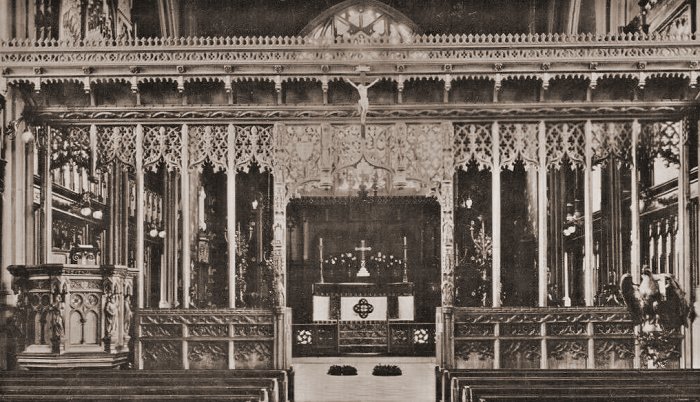
The interior of Christ
Church. From an old postcard. |
|
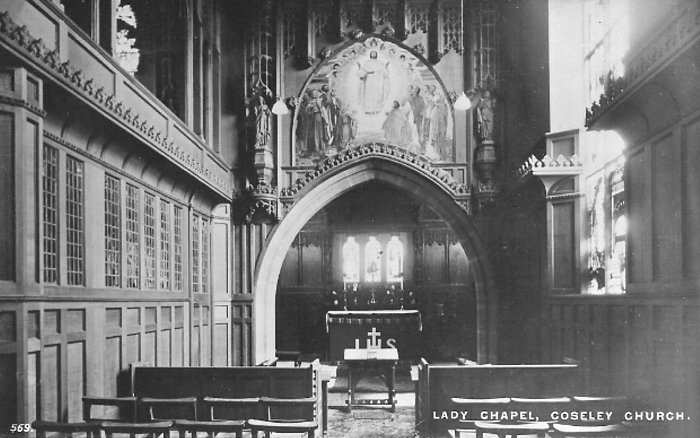
From an old postcard. |
Holy Trinity Church, Ettingshall
In 1834, the foundation stone of
Holy Trinity Church in Mill Street (now Millfields
Road), Ettingshall, was laid. It was built to serve the
large population to the north of Sedgley parish. It was
a timber-framed building, designed by Robert Ebbels, an
architect based in Trysull and Tettenhall Wood. Services
were held in the church by 1835. Holy Trinity Parish was
constituted in 1841.
It is probable that the church did
not have any substantial foundations, which resulted in
it being replaced in 1874 by a masonry built church in
English Gothic Style, with a nave, chancel, transepts
and north aisle. A Sunday School was also built on the
western side of the church.
The church was replaced by the
Church of the Most Holy Trinity in Farrington Road,
which was consecrated in 1961. The original site is now
occupied by Tarmac.
St. Mary’s Church, Gorge Road,
Hurst Hill
St. Mary’s Church, built in 1872,
was designed by George Bidlake. It was built at a cost
of around £4,000, in local stone, with a nave, a chancel
and aisles, and accommodation for approximately 550
people. St. Mary's Parish was formed on December
16th, 1873. The chancel, added in 1882, was designed by
Thomas Henry Fleeming of Wolverhampton. The first vicar
was Thomas Ridsdel, who remained there until 1892.
The church is now called St. Mary the Virgin and is
part of the benefice of Christ Church, Coseley, within
the Diocese of Worcester.
St. Chad's Church, Oak Street,
Coseley
Christ Church Parish was one of the
largest parishes in the area. A mission district was
formed in 1879 on the southern side of the parish, with
Father George Castriot de Renzi as Mission Priest.
Initially services were conducted
in the room of a house in George Street, Swan Village, or
in the National Schools at West Coseley. The
congregation became parishioners of St. Chad's and
formed the nucleus of the congregation when the church
was built.
|
|
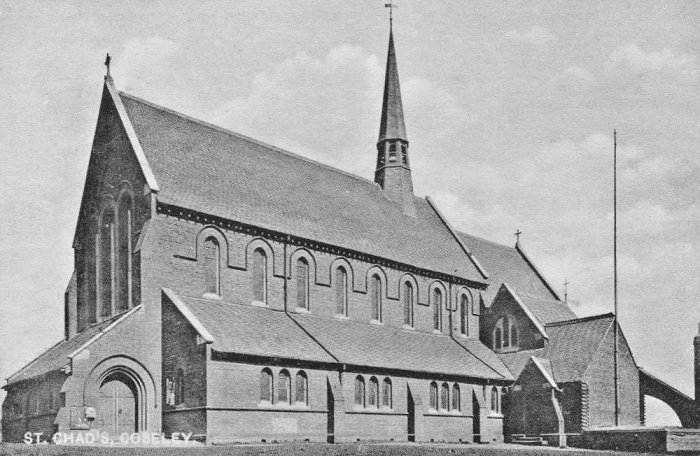
From an old postcard. |
|
Lord Dudley gave a piece of land on
which to build a church, along with £1,000 towards the
building costs. The remaining money was provided by the
Incorporated Church Building Society and the Church
Extension Society. The final cost was around £4,000.
The Foundation stone was laid on St. Chad’s Day, 2nd
March, 1882 and the church was consecrated on the 28th
March, 1883. It became a separate Parish on the 14th
April, 1884.
The Church is built of red brick
and supported by stone pillars, after the Early English
style of Victorian Gothic architecture. It was designed
by Thomas Henry Fleeming of Wolverhampton and has a
chancel, a nave, north and south aisles, and a porch at
the west end. The Lady Chapel lies at the east end of
the south aisle and contains the only pillar that is
carved. The Church was originally built with a small
spire housing a single bell. The choir stalls are from
Christ Church and appear to be the ones that were placed
there during the 1866 restoration.
In 1896, Lord Dudley gave an
adjacent piece of land on which to build the vicarage.
The choir vestry was added in 1923 and the organ chamber
in 1925. The spire was removed in 1967 and replaced with
a bell housing at the west end of the south aisle. The
organ is a large instrument, built by Nicholson of
Worcester. It was erected by members of the
congregation. A memorial east window was added to the
chancel, as a memorial to those who lost their lives
during the Second World War.
|
 |
|
 |
|
 |
Return to
Early Records |
|
Return to
the
Contents |
|
Proceed to
Canals |
|